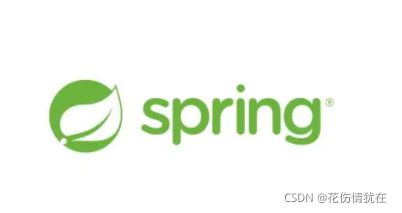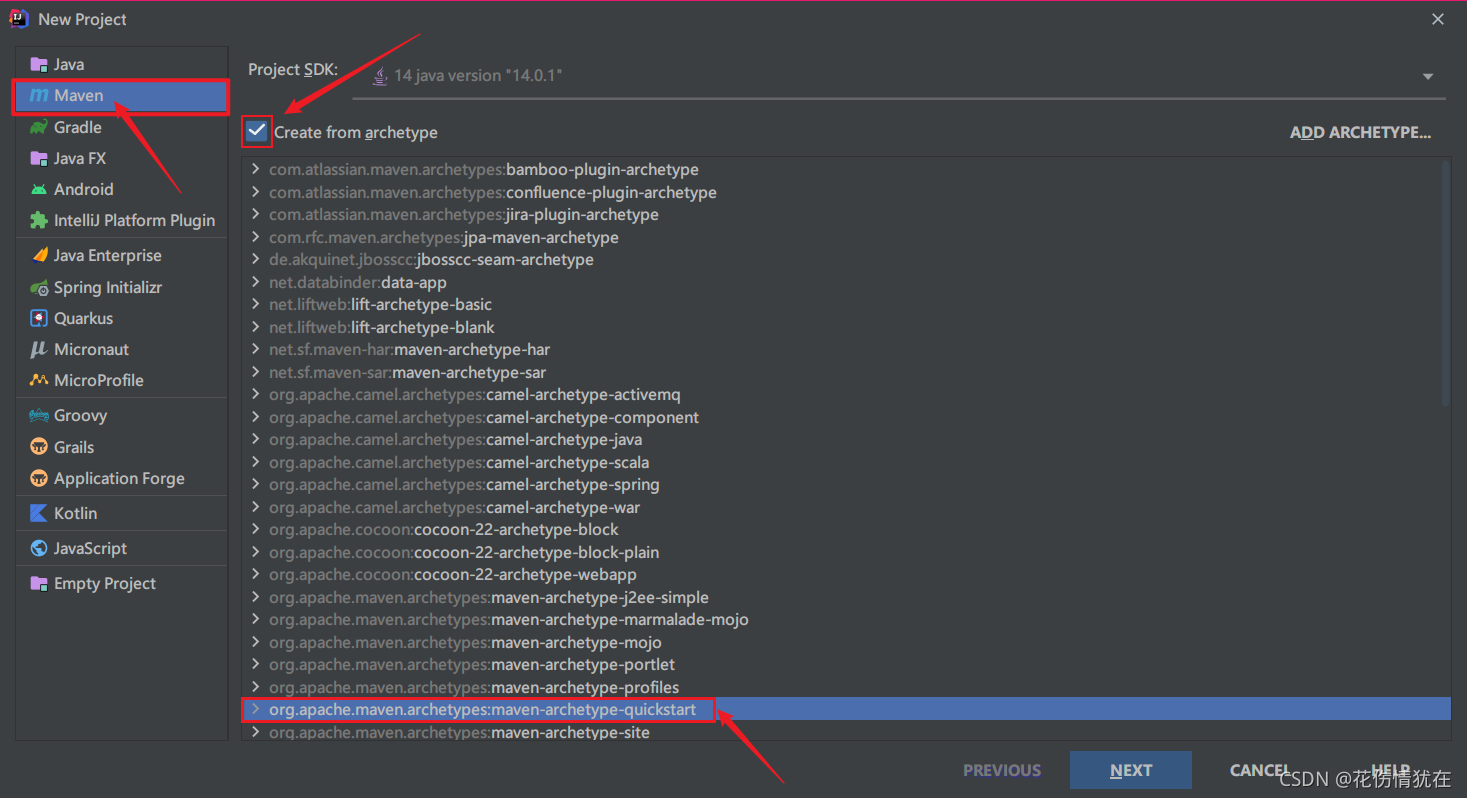开发工具准备
开发工具:idea2017 以上
依赖管理:maven3 以上
jdk:1.8 以上

使用Maven创建Spring项目
- 选择Maven
- 勾选Create from archetype
- 选择maven-archetype-quickstart

填写项目信息

指定maven

创建成功

使用Java Enterprise创建Spring项目
默认即可

Version一般选择Java EE 8

设置项目信息

创建成功

引入 maven 依赖 pom.xml
打开pom文件添加依赖
<!-- 日志输出 -->
<dependency>
<groupId>log4j</groupId>
<artifactId>log4j</artifactId>
<version>1.2.17</version>
</dependency>
<!--spring-context -->
<dependency>
<groupId>org.springframework</groupId>
<artifactId>spring-context</artifactId>
<version>5.0.3.RELEASE</version>
</dependency>
<!--junit单元测试 -->
<dependency>
<groupId>junit</groupId>
<artifactId>junit</artifactId>
<version>4.13</version>
<scope>test</scope>
</dependency>
刷新

检查依赖

定义接口与实体类
接口
public interface SomeService {
void doSome();
}
实现类
public class SomeServiceImpl implements SomeService {
//无参构造器
public SomeServiceImpl() {
System.out.println("SomeServiceImpl无参数构造方法");
}
@Override
public void doSome() {
System.out.println("====业务方法doSome()===");
}
}
创建 Spring 配置文件
在 src/main/resources/目录现创建一个 xml 文件,文件名可以随意,但
Spring 建议的名称为 applicationContext.xml。
注意:spring 配置中需要加入约束文件才能正常使用,约束文件是 xsd 扩展名。
IDEA工具默认提供Spring模板
选中resources包>New>XML Confiquration File >Spring Config

创建成功

默认模板说明
<?xml version="1.0" encoding="UTF-8"?>
<beans xmlns="http://www.springframework.org/schema/beans"
xmlns:xsi="http://www.w3.org/2001/XMLSchema-instance"
xsi:schemaLocation="http://www.springframework.org/schema/beans http://www.springframework.org/schema/beans/spring-beans.xsd">
</beans>
spring标准的配置文件:
1)根标签是 beans
2) beans 后面的是约束文件说明
3)beans里面是bean声明。
4)什么是bean: bean就是java对象, spring容器管理的java对象,叫做bean
注册bean对象
<?xml version="1.0" encoding="UTF-8"?>
<beans xmlns="http://www.springframework.org/schema/beans"
xmlns:xsi="http://www.w3.org/2001/XMLSchema-instance"
xsi:schemaLocation="http://www.springframework.org/schema/beans http://www.springframework.org/schema/beans/spring-beans.xsd">
<!--注册bean对象
id:自定义对象的名称,通过id在代码中使用对象
class:类的全限定名称,不能是接口
-->
<bean id="someService" class="service.Impl.SomeServiceImpl"></bean>
</beans>
- bean标签:用于定义一个实例对象。一个实例对应一个 bean 元素。
- id:该属性是 Bean 实例的唯一标识,程序通过 id 属性访问 Bean,Bean
与 Bean 间的依赖关系也是通过 id 属性关联的。 - class:指定该 Bean 所属的类,注意这里只能是类,不能是接口。
定义测试类
测试类定义在根目录下的test包下的java包里面
这里我们创建一个test1(名称任意)测试类

spring代理SomeServiceImpl对象

测试spring容器中代理someServiceImpl对象
import org.junit.Test;
import org.springframework.context.ApplicationContext;
import org.springframework.context.support.ClassPathXmlApplicationContext;
import service.SomeService;
public class test1 {
@Test
public void test1(){
//指定spring配置文件的位置和名称
String resources = "applicationContext.xml";
//创建spring容器对象
ApplicationContext applicationContext = new ClassPathXmlApplicationContext(resources);
//从spring容器中获取对象,使用id
SomeService someService = (SomeService)applicationContext.getBean("someService");
//执行对象的业务方法
someService.doSome();
}
}
成功运行spring代理的someServiceImpl对象

使用 spring 创建非自定义类对象
简单来说就是spring可以创建自定义的对象,也可以创建非自定义的对象。
上面spring代理创建的对象就是我们自定义的对象,我们可以通过spring代理非自定义的对象,例如java下的日期类(Date):
spring 配置文件加入 java.util.Date 定义:
<bean id="myDate" class="java.util.Date" />
如图

test1 测试类中:
调用 getBean(“myDate”); 获取日期类对象。

容器接口和实现类
ApplicationContext 接口(容器)
ApplicationContext 用于加载 Spring 的配置文件,在程序中充当“容
器”的角色。其实现类有两个:
使用Ctrl+H可以查看类的继承关系

ClassPathXmlApplicationContext和FileSystemXmlApplicationContext的区别
ClassPathXmlApplicationContext[只能读放在web-info/classes目录下的配置文件]
- 默认就是指项目的classpath路径下面
- 如果要使用绝对路径,需要加上file:前缀表示这是绝对路径
使用ClassPathXmlApplicationContext指定spring配置文件位置
默认就是指项目的classpath路径下面
ApplicationContext applicationContext = new ClassPathXmlApplicationContext("applicationContext.xml");
加上file表示使用绝对路径指定spring配置文件位置
ApplicationContext applicationContext = new ClassPathXmlApplicationContext("file:G:/IDEA/S3/Spring/demo1/src/main/resources/applicationContext.xml");
FileSystemXmlApplicationContext:
- 默认是项目工作路径,即项目的根目录
- 有file表示的是文件绝对路径
- 如果要使用classpath路径,需要前缀classpath
使用FileSystemXmlApplicationContext指定spring配置文件位置
默认是项目工作路径,即项目的根目录,而我们的配置文件在根目录下的src/main/resources下面
ApplicationContext applicationContext = new FileSystemXmlApplicationContext("src/main/resources/applicationContext.xml");
加上file表示的是文件绝对路径
ApplicationContext applicationContext = new FileSystemXmlApplicationContext("file:G:/IDEA/S3/Spring/demo1/src/main/resources/applicationContext.xml");
使用classpath路径,需要前缀classpath,相当于ClassPathXmlApplicationContext
ApplicationContext applicationContext = new FileSystemXmlApplicationContext("classpath:applicationContext.xml");
配置文件在类路径下
我们的配置文件一般件存放在项目的类路径下,则使用ClassPathXmlApplicationContext 实现类进行加载。

ApplicationContext 容器中对象的装配时机
ApplicationContext 容器,会在容器对象初始化时,将其中的所有对象一次性全部装配好。以后代码中若要使用到这些对象,只需从内存中直接获取即可。执行效率较高。但占用内存。

代码
public class test1 {
//ApplicationContext容器对对象的装配时机
@Test
public void test1(){
//获取容器:此时容器中的所有对象均已装配完毕
ApplicationContext applicationContext = new ClassPathXmlApplicationContext("applicationContext.xml");
}
}
使用 spring 容器创建的 java 对象

- spring容器在运行的时候会先读取applicationContext.xml配置文件
- spring读取配置文件, 一次创建好所有的java对象, 都放到map中。
- 通过applicationContext.getBean(“bean对象的id”)获取代理对象
